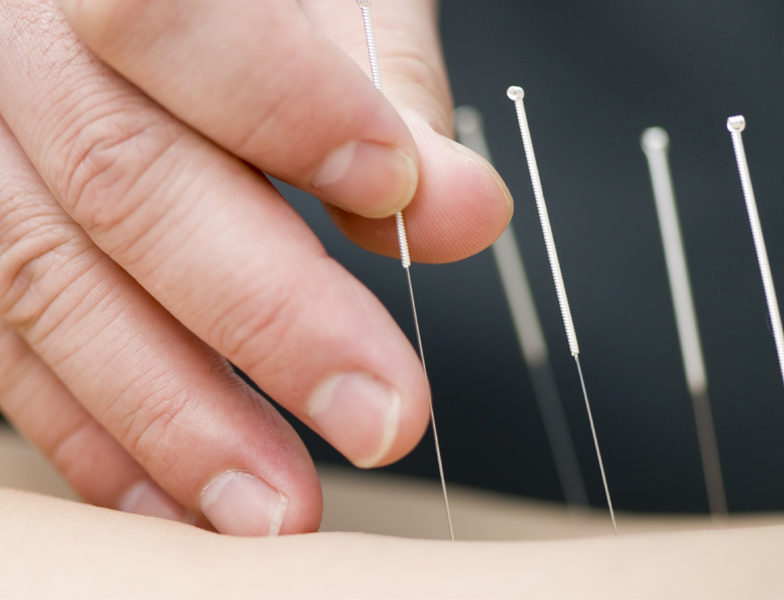Dry needling and myofascial
![]()
Dry needling is quite a new approach to treating spasmed and distressed muscles.
Dry needling should not be confused with acupuncture — they both have different goals and target different health issues. During the acupuncture session a therapist inserts needles at acupuncture points which are located at the meridian lines, each line representing the functioning of internal organs. The concept of the meridian lines were developed in Ancient China; acupuncture targets the dysfunctions of internal organs (indigestion, issues with fertility, stress, insomnia).
Dry needling also involves the usage of acupuncture needles, but they are inserted at the muscular trigger points that were developed due to stressed, overused, tense muscles. The needle releases the tension in the muscle, although at first one might experience muscle twitch or a sensation of a cramp in the muscle.
Dry needling treats a number of issues that include:
-
acute and chronic muscle and joint pain
-
problems with range of motion
-
dysfunction of joint
-
recovery from an injury.
Specialists recommend dry needling for people who want to find and eliminate neuromuscular dysfunctions that leads to pain and functional deficits.
Common Conditions Treated With Dry Needling:
- Acute and chronic pain
-
Lower back pain
-
Tendonitis
-
Carpal tunnel syndrome
-
Disk pathology
-
Neck/Backache
-
Shoulder Pain
-
Tennis/Golfer’s Elbow
-
Hip and Gluteal Pain
-
Headaches
-
Knee Pain
-
Plantar Fasciitis
-
Sciatica
Sessions of dry needling technique, paired with remedial massage, will help speed your recovery. A course of dry needling allows the therapist to deliver the muscular relief in the deep tissue or directly in the joint, rather than on the surface of the skin (as in a case of a massage course). Surprisingly, dry needling is also found to be less painful when performed on the tense muscles — compared to the massage work done on the cramped, spasmed muscle group.
People commending dry needling:
http://www.everydayhealth.com/columns/my-health-story/dry-needling-most-painful-thing-ever-loved/
What is subluxation?
Tense muscles, that stretch from each vertebra, have the potency to pull the vertebra out of its natural spinal alignment. The dislocated vertebra starts to pinch and compress the spinal cord, causing pain and making the muscles surrounding the “slipped” vertebra cramp even more as the body tries to guard and protect the sore spot.
A variety of symptoms can point to the chiropractic (or vertebral) subluxation, which is an incomplete partial dislocation of a vertebral segment.
Neck and backache are the most obvious symptoms of any misalignment of a vertebra. But in reality it might cause many more pains and restrictions in our daily life:
-
Frequent and intense headaches
-
Dizziness or balance problems
-
Spinal muscle spasms, tightness or weakness
-
Reduction in spinal mobility
-
Pain, numbness or tingling in the limbs
-
Joint pain or stiffness
-
General lack of energy
-
Health declining
-
Reduced ability to heal tissue
Reason
There are plenty of reasons why the natural curve of our spine gets out of shape. It can happen due to
-
Macro-stress
-
a physical trauma (a sport trauma, a car accident, an unfortunate fall)
-
-
Or micro-stress (repeated over an extended period of time)
-
poor habits in our posture (slouching, sitting askew at the computer table, having a “favourite” shoulder to carry a bag)
-
a tight (overworked, stressed) muscle that pulls the vertebra out of its place
-
prolonged stress
-
Since a segment of the vertebrae is out of alignment, it pinches a nerve or irritates a nerve, which in turn sends wrong signals to the brain indicating that there is shoulder pain, or numbness of fingers, or pain in the chest with every breath you take.
Apart from the constant pain and discomforts, after a prolonged time untreated subluxation can lead to calcium deposits in the area of the vertebra and bone deposits — the surface of the bone becomes rough and causes the compressed discs to lose its cushioning function. The problem becomes chronic.
Vertebral subluxation can be also brought about by a strained/overworked muscle. This is how it happens:
-
We tend to strain the body to guard and protect the place that was traumatised — whether by slightly leaning into our affected side, or walking with one hip slightly more forward than another.
-
The restrained movement of the muscle leads to immobility of the involved vertebrae, and, as the result, to the degeneration and deformation (bulging) of the spinal disks.
Solution
The best recommendation to ease the symptomatic pain and eliminate the cause of vertebra misalignment is to use a combined approach. Our remedial practice provides sessions of recovery massage and dry needling to treat the condition and bring the sought relief.
Dry needling technique elicits favourable mechanical and biochemical effects on the tense tissues — the filament (the needle) evokes the twitch responses, which are spinal cord reflexes. Getting local twitch responses with dry needling is the first step in breaking the pain cycle and relaxing the affected muscles.
Our clinic has been using the dry needling technique successfully for several years already and have a great number of clients who have been benefitted by this therapy. The greatest advantage of the dry needling therapy being:
-
simplicity of treatment
-
painlessness of the procedure
-
effectiveness in direct approach to the affected tissues


